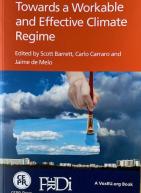Reducing emissions of greenhouse gases and air pollutants is a key issue on the agenda of both public regulators and private firms. On the one side, firms seek to adopt more environmentally friendly production methods to fill institutional voids, to become more efficient in the use of energy and resources, or simply to signal their socially responsible behaviour to customers and policymakers (Darnall et al. 2008, Baek 2017).
On the other side, policymakers have been led by environmental concerns to introduce elements of environmental protection regulation not only in their domestic legislation, but also in various international instruments, such as multilateral conventions and, more recently, bilateral trade agreements (Lechner 2016).
The effectiveness of private (voluntary) environmental regulations in reducing emissions has been contested (Boiral et al. 2018). Certifications such as the ISO-14001 can induce firms to make substantial investments and train personnel to reduce their environmental impact (Potoski and Prakash 2013). However, firms have also been observed to vary their level of compliance with the standards’ requirements depending on the likelihood of monitoring and expected sanctions (Christmann and Taylor 2006).
The success of public environmental regulation, especially when involving trade agreements, is also not free of criticism. The EU has often used its commercial power to ‘export’ its regulatory model to third countries, by making preferential access to EU markets conditional on compliance with non-trade objectives such as environmental protection (Borchert et al. 2020). Countries that have signed up for environmental protection provisions in their bilateral trade agreement with the EU include Canada, Chile, Colombia, Croatia, Mexico, Peru, Singapore, South Africa, South Korea, and Vietnam. Yet, the trade and sustainable development chapters in EU trade agreements have been often considered to lack necessary vigour because they do not have enforcement mechanisms that can be adopted in case of violations.
Complementarities between public and private regulation
With production being increasingly internationalised and many multinational enterprises’ headquarters based in large, green-conscious markets such as the EU, there is scope to consider the role of complementarities that might arise between private and public environmental regulations.
Tighter public regulations can complement private standards such as the IS0-14001 by making companies more aware of the potential resource efficiencies and innovations from minimising waste and pollution. Such regulations can help level the playing field by reducing opportunistic behaviour (Porter and Van der Linde 1995). Trade agreements with environmental protection provisions could improve the enforceability of private ISO-14001 standards; they could enhance the effect of the standards on the environment through reduced levels of pollution.
ISO standards can also help push trade agreements to include environmental protection provisions. The EU’s economic weight could in fact act indirectly through the so-called ‘Brussels effect’ (Sinopoli and Purnhargen 2016). This effect works through the intermediation of EU firms which serve as de facto inspectors of their subcontractors in third countries. The EU firms make sure that the subcontractors satisfy a range of product and process standards to be part of EU-based value chains (Héritier et al 2009).
In a recent paper (Di Ubaldo et al. 2019), we investigate the extent to which environmental protection provisions in EU trade agreements affect emissions of greenhouse gases and air pollutants, and whether their effect is complementary to that of private ISO 14001 certifications.
We exploit a dataset with information on the number of ISO-14001 certifications (from the ISO survey), emissions (from the Environmental Performance Index report), and the ‘environmental content’ of EU free trade agreements (Lechner 2016), for 147 countries over the 1999–2014 period.
Figure 1 shows the uptake of ISO-14001 certifications over time by groups of countries which, from 1999 onwards, were always members of EU agreements with environmental protection provisions (e.g. EU members, north-African countries), entered such agreements (e.g. member of European Partnership Agreements, Canada, Chile), never entered EU agreements (e.g. India, Russia and the USA), and China, the country with the largest number of certifications. The growth of ISO-14001 certifications was rapid but uneven.
Figure 1 ISO-14001 certifications and members of EU agreements with environmental protection provisions
Note: EP = environmental protection.
Source: Authors’ elaboration on data from ISO survey and Lechner 2016.
Countries always in EU free trade agreements with environmental protection provisions kept increasing the number of ISO-14001 certifications over time and so did China, at an even faster rate. In countries that never entered EU free trade agreements, the growth of ISO-14001 certifications seems to have plateaued post-2009. Joiners of EU free trade agreements find themselves in the middle, exhibiting a modest growth of ISO certifications throughout the period under analysis.
We exploit a dynamic panel setting to estimate the impact of ISO-14001 certifications, EU agreements with environmental protection provisions, as well as their interaction, on the level of emissions of greenhouse gases and pollutants. The results paint a somewhat more complicated picture than might be expected.
Membership in EU trade agreements with environmental protection provisions is associated with lower emissions of harmful pollutants, sulphur dioxide and nitrogen oxide. In comparison, ISO-14001 certifications are strongly associated with lower emissions of carbon dioxide and methane, which account for approximately 90% of all greenhouse gases.
For carbon dioxide, we find evidence of an interaction effect of ISO-14001 with EU trade agreements: the negative impact of the certifications on emissions is driven by the subsample of members of EU agreements with environmental protection provisions, with no effect of ISO-14001 for countries not part of such agreements. By themselves, EU agreements are found to have no impact on carbon-dioxide emissions.
Conclusion
The challenges of global warming and climate change require a coordinated effort by a variety of stakeholders, including businesses and governments. Emissions of air pollutants and greenhouse gases contribute to global warming and climate change and will increasingly adversely affect human health and sustainable development (Kolk and Pinkse 2008).
We find that ISO-14001 certifications interact with an element of public environmental regulation, i.e. the environmental protection provisions in EU free trade agreements, in reducing emissions of carbon dioxide. While public and private regulation by themselves appear to affect different kinds of emissions, the complementarity emerging for carbon-dioxide emissions suggests a potential avenue for further coordinated efforts to reduce emissions.
References
Baek, K (2017), “The diffusion of voluntary environmental programs: The case of ISO 14001 in Korea, 1996–2011”, Journal of Business Ethics 145(2): 325–36.
Boiral, O, L Guillaumie, I Heras‐Saizarbitoria and C V Tayo Tene (2018), “Adoption and outcomes of ISO 14001: A systematic review”, International Journal of Management Reviews 20(2): 411–32.
Borchert, I, P Conconi, M Di Ubaldo and C Herghelegiu (2020), “EU trade policies: Carrot-and-stick mechanisms in the pursuit of non-trade policy objectives?”, VoxEU.org, 5 May.
Darnall, N, I Henriques and P Sadorsky (2008), “Do environmental management systems improve business performance in an international setting?”, Journal of International Management 14(4): 364–76.
Christmann, P, and G Taylor (2001), “Globalization and the environment: Determinants of firm self-regulation in China”, Journal of International Business Studies 32(3): 439–58.
Christmann, P, and G Taylor (2006), “Firm self-regulation through international certifiable standards: Determinants of symbolic versus substantive implementation”, Journal International Business Studies 37: 863–87.
Di Ubaldo, M, S McGuire and V Shirodkar (2019), “The effect of ISO 14001 certifications on emissions: Any role for EU agreements with environmental protection provisions?”, RESPECT mimeo, December.
Héritier, A, A K Mueller-Debus and C R Thauer (2009), “The firm as an inspector: Private ordering and political rules”, Business and Politics 11(4): 1–32.
Kolk, A, and J Pinkse (2008), “A perspective on multinational enterprises and climate change: Learning from ‘an inconvenient truth’?”, Journal of International Business Studies 39(8): 1359–78.
Lechner, L (2016), “The domestic battle over the design of non-trade issues in preferential trade agreements”, Review of International Political Economy 23(5): 840–71.
Porter, M E, and C Van der Linde (1995), “Toward a new conception of the environment-competitiveness relationship”, Journal of Economic Perspectives 9(4): 97–118.
Potoski, M, and A Prakash (2013), “Do voluntary programs reduce pollution? Examining ISO 14001's effectiveness across countries”, Policy Studies Journal 41(2): 273–94.
Sinopoli, D, and K Purnhargen (2016), “Reversed harmonization or horizontalization of EU standards: Does WTO law facilitate or constrain the Brussels effect”, Wisconsin International Law Journal 34: 92.






